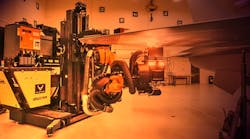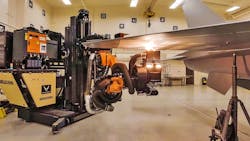The Air Force spent seven years developing a new way to remove paint from metallic and carbon-fiber aircraft surfaces, the newly-adopted Robotic Laser Coating Removal System.
Paint removal is a common maintenance procedure for military aircraft and is performed for a variety of reasons, most notably for inspections and prior to repainting. Typically, it is done manually, with maintenance crews using a chemical solution, media blasting, meticulously scraping or sanding off the paint, or employing some combination of these three processes. But these procedures are time-consuming and create a large amount of potentially hazardous waste material. They are also labor-intensive and uncomfortable, requiring teams of maintenance crews equipped with several types of safety gear.
The new removal approach uses a laser-equipped robotic arm mapped individually and specifically to each aircraft that moves over the vehicle surface, essentially vaporizing paint layer by layer. The process is completely contained, so all waste materials as well as potentially harmful chemicals are vacuumed into the tool. A vision subsystem recognizes when the stripping reaches the appropriate stopping point.
The newly-approved Robotic Laser Coating Removal System vaporizes paint off an F-16 in a self-contained process that significantly reduces environmental hazards to maintainers. (Photo courtesy of University of Dayton Research Institute/Dale Jackson)
It’s a completely automated process that removes the direct human element, both in terms of error and exposure. Instead, operators guide the effort from a computer console in a nearby control room.
Because the paint is removed with a laser, as opposed to traditional mechanical or chemical methods, the Air Force team had to take into consideration a whole new set of factors when developing test plans and evaluating the structural soundness of test specimens. Three areas in particular concern the thermal aspect of the removal which could cause cadmium embrittlement (the formation of intermetallics on the material), thermal damage to the material itself, and thirdly, any relaxation of residual stress due to thermal effects.
The laser de-paint process is much safer, significantly reducing the environmental hazards posed by chromium-based paint products. The fully-automated process does not require maintenance crews to be in the paint stripping area. And because the process is contained, waste is automatically removed to a collection area, requiring little cleanup by personnel. The process is also faster, saving significant labor hours and associated costs.
Although not every surface material is suitable for laser paint removal, the system is approved for use with specific types of aluminum and graphite epoxy composites with a service temperature greater than 350°F. The system is currently being investigated for a number of other materials and air platforms as well, and AFRL will play a continuing role in these efforts.


